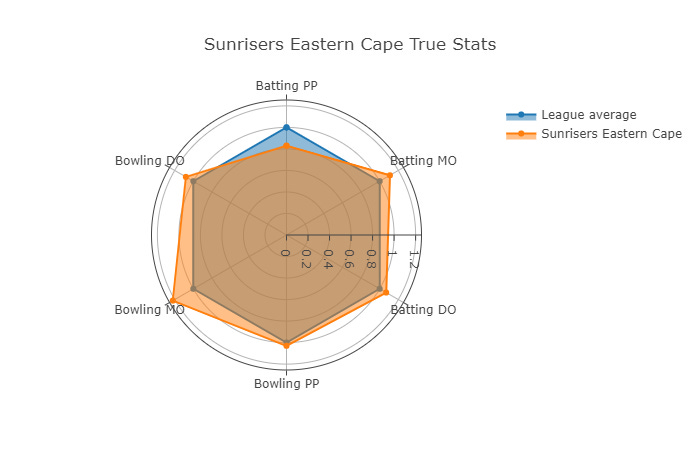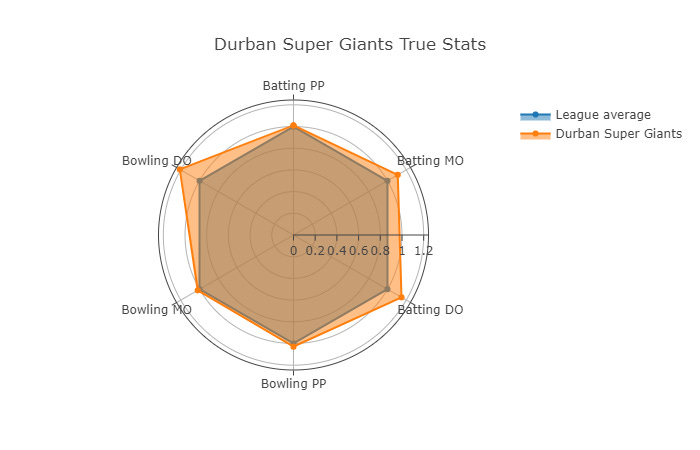SA20 Teams: Sunrisers and DSG
A brief look at what the teams did well and what they didn't excel at
Thank you for reading 438 & Beyond. If you like what you read, please click the button below, join the mailing list for FREE, and share on social media, through e-mail, or however you feel comfortable sharing.
Please consider becoming a Patron or buying a coffee to support this project and keep things going.
Adi Birrell’s back-to-back champions had one weakness in Season 2: they were handicapped by slow starts. They had the lowest strike rate in the powerplay, 111.6. For a moment, I thought it was because St George’s Park had the lowest strike in the first six overs. St George’s had an average PP strike rate of 118. At home, SEC went at 111.8, while visiting teams went at an average strike rate of 125.
SEC wasn’t better on the road either. They went at 111.51 in the first six overs, while everyone else had an average strike rate of 134.55.
They offset this slow start by not losing a lot of wickets in the powerplay. They lost a mere 1.2 wickets in this period. Only MICape Town, who lost 0.9 wickets in the powerplay, lost fewer wickets.
This is why their acquisition of Zak Crawley caught my attention. On the surface, Zak Crawley looks like an upgrade on Dawid Malan. He has a T20 strike rate of 135.1 compared to Malan’s 129.1. If you use the Good Areas True Stats model, Malan has a true strike of 1.23, while Crawley’s true strike rate is 10.74.
This looks good until you look closely. Crawley hasn’t done well in T20 cricket since 2022. Between 2022 and now, he has averaged 19.9 at 114.8. Malan, on the other hand, averages 33.8 at 132.1. Converted to true stats, Malan has a true average of 8 and a true strike rate of -0.65, while Crawley has a true average of -7.3 and a true strike rate of -7.96.
These stats are not flattering for Crawley. It will be interesting to see how he navigates St George’s Park’s tricky powerplays. There is also a question mark on how Birrell will use David Bedingham. If he comes in at 5, that would mean that Tristan Stubbs and Marco Jansen bat a slot down, which would leave Beyers Swanepoel and Patrick Kruger fighting for the 8 and 9th slots - which is not entirely a bad thing.
A longer batting lineup could facilitate quicker starts.
SEC made up for the slow powerplay by being the second-best batting side in the middle overs (34.7 at 139). This is when the Aiden Markram effect kicked in. According to true stats, Markram (38 at 141.8) had a true average of 16.4 and a true strike rate of 18.3. Tom Abell was another big contributor in the middle overs, but Markram was the cornerstone.
The platform created by Markram and Abell set the platform for Tristan Stubbs and Marco Jansen to go berserk. Thanks to the pair, SEC registered the second-best strike rate at the death, just behind Durban Super Giants, who went insane.
But, despite doing well in the middle overs and at the death with the bat, SEC was a bowling team. Marco Jansen, Ottniel Baartman and Daniel Worrall were the leading wicket-takers in the league. None had an economy of eight runs an over or more and none had a strike rate of 15 or more.
Thanks to this trio, no other team dominated with the ball as much as they did. The SEC bowling attack did many great things up front, they delivered the most dot balls, conceded the least fours and had the best strike rate and economy in the powerplay.
Only one member of this trio, Worrall, will be missing in season 3. SEC has replaced him with Richard Gleeson, professional cricket’s late entry. The 36-year-old is only nine years into his career. Despite the late start, Gleeson has quickly made a name for himself on the T20 circuit as a reliable bowler. His attacking lengths in the middle overs and control and mastery of the yorker at the death make him a valuable addition to the SEC team.
Roelof van der Merwe’s return is another boon for SEC. The Dutchman was outstanding in season one. SEC has also been trying to get Craig Overton to St George’s Park. Last season that plan was scuppered when Overton suffered an injury. Like Gleeson, Overton is a classic SEC signing.
In season 3, we can expect more of the same as what they did in season 2.
Sunrisers Eastern Cape: Aiden Markram, Zak Crawley (England), Roelof van der Merwe (Netherlands), Liam Dawson (England), Ottneil Baartman, Marco Jansen, Beyers Swanepoel, Caleb Seleka, Tristan Stubbs, Jordan Hermann, Patrick Kruger, Craig Overton (England), Tom Abell (England), Simon Harmer, Andile Simelane, David Bedingham, Okuhle Cele, Richard Gleeson (England), Daniel Smith (rookie).
The saying goes: everyone loves a good busker because their music creates a wonderful ambience. However, for the busker to keep busking, someone needs to put some money into the hat.
I am a busker and this is my hat:
Durban Super Giants
Like the Sunrisers, DSG had a batting powerplay problem. Despite it being the fifth-best in the league, their strike rate in the first six overs wasn’t their main issue. They went at a rate slightly above the par score, which was okay. Their issue was that they didn’t have anyone who could stick around for long enough to build an opening partnership with Matthew Breetzke.
Their powerplay partnerships were so bad that they had the second-worst average per wicket. According to the Good Areas model, they lost 2.7 wickets more than expected in the first six overs.
This is probably what informed their signing of Kane Williamson for season 3. The New Zealander has the ability to arrest collapses and steady the ship. Kane’s inclusion in the top three points towards an opening partnership of Matthew Breetzke and Quinton de Kock, which we didn’t a lot of in season two, with Brandon King as a backup.
In the middle overs, last season it was Heinrich Klaasen or bust. The Proteas star batted at five or six for most of the season and yet he found himself at the crease in the seventh over, more often than not. His average entry point was after 7.2 overs. Fortunately for them, the Klaasen gamble came off enough times for them to make it all the way to the final.
To explain how massive Klaasen was for DSG, let’s use numbers. He averaged 51.8 at 186.3 in the middle overs. In true stats, that’s an average and strike rate of 35.12 and 74.98. The only other batter with stats worth talking about is Wiaan Mulder, who averaged 46 at a strike rate of 140.8 in the middle overs, for true stats of an average of 23.5 and a strike rate of 6.4.
Their best batting period was at the death. Again, thanks to Klaasen, who averaged 37 at 250.67, for a true average of 22.58 and a true strike rate of 81.61.
Allan Donald joining DSG means the Newlands side now has three South African greats in the changeroom: Lance Klusener, Jonty Rhodes and Allan Donald. The former pacer is one of the best South African fast bowlers ever. No one really gets mad if you name him as number one. He is definitely in the top three. He is also one of the best fast-bowling coaches South Africa has produced.
His arrival is probably what DSG needed. Nine of the top 10 wicket-takers from season 2 were pacers, and yet DSG's highest-ranked pacer was Junior Dala, who was ranked seventh. Despite making it to the final, their fast bowlers did not take enough wickets to put teams under pressure.
In the powerplay, DSG's bowlers did enough to prevent teams from taking off on a flier but did not complement that economy with a good strike rate. In the middle overs, they did the opposite, they had the best strike rate and a high economy. They only managed to get a good strike rate and a good economy at the death, no one else did what they did in the final four overs.
With the attack they have, Chris Woakes, Naveen-ul-Haq, Junior Dala and Shamar Joseph (if he is available), DSG could cause problems for batters in the powerplay. If they get that part right...
We might see a different approach with the bat in the powerplay in season 3.
DSG squad: Brandon King (West Indies), Quinton De Kock, Naveen-ul-Haq (Afghanistan), Kane Williamson (New Zealand), Chris Woakes (England), Prenelan Subrayen, Dwaine Pretorius, Keshav Maharaj, Noor Ahmad (Afghanistan), Heinrich Klaasen, Jon-Jon Smuts, Wiaan Mulder, Junior Dala, Bryce Parsons, Matthew Breetzke, Jason Smith, Marcus Stoinis (Australia), Shamar Joseph (West Indies), CJ King (rookie)






